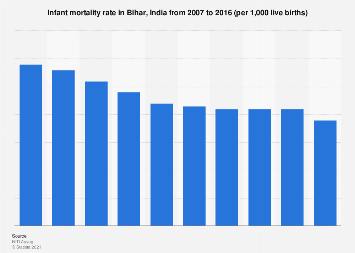Infant Mortality Rate in Bihar from being one of the states with highest infant mortality to its rapid decrease in infant mortality and rise in health of mothers and child. The infant mortality rate was calculated in Bihar, India per 1000 live births, 2007 to 2016 as the number of children who die before one year of age per 1000 live births.
Also Read : Mid-Day Meal Programme : Its Launch, budget, Reach, Importance and Role of States in the Scheme
Statistics and information depicting the change and decrease in Infant mortality rate in Bihar
The Infant mortality rate (IMR) in Bihar decreased from 48.1% to 46.8%, and the infant mortality rate (IMR) decreased from 58.1% to 56.4%. The survey results show that 43.1% of IMRs are registered in the urban environment. Neonatal Tetanus was the leading cause of infant death in Bihar at 36.4%.
In 2019, India’s mortality rate ranged from 5 in urban areas to 6.5 in rural areas and death rate in the Union states / territories ranged from 3.2 in Delhi to 7.3 in Chhattisgarh in 2019. According to figures released by the General Chancellor of India in 2018 the national fertility rate was 20, and infant mortality and mortality rates were 6.2 and 32 respectively. The infant mortality rate (IMR) in India in 2019 is 30 per thousand live births but there is a huge difference in numbers between the various States and Territories of the Union according to the latest demographic survey conducted by the Ministry of Health.
Bihar It is also the state with the highest under-five infant mortality rate at 56.4, compared with Kerala 5.2, Bengal 25.4 and Gujarat 37.6. Speaking to NDTV about the state government’s initiatives to reduce infant mortality, Dr. Syed Hubbe Ali, a health professional in UNICEF in Bihar, said most deaths in the state occur in the neonatal period, the first month of birth or premature babies.
The low overall utilization of maternal care services and the relatively high newborn mortality rate in India’s Bihar state as reported in this paper underscore the need for special attention to ensure that maternal and newborn health care is provided to a much larger percentage of women than the current level. Focusing on the prevention of preterm and low birth weight can help eliminate infant mortality rate and reduce inequalities in health care within communities.
Also Read : I Rakhwali App: Application launch and its Reliability
Other relevant information about Infant mortality
The ratio for a given area is the number of children who die before one year old multiplied by the number of live births per year, multiplied by 1,000. Postpartum mortality refers to the number of deaths from 29 days to one year old. India’s neonatal mortality rates vary significantly with 39 per 1000 live births in Madhya Pradesh in the northern region and Odisha in the eastern region at more than five times higher, for example. Bihar has the highest birth rate with 26.2, while the Andaman and Nicobar Islands have 11.2. The indicator at the Indian level has declined over the past decade from 7.2 to 6; mortality was highest among children of young illiterate mothers with low per capita income.
A 2019 study published in the British Medical Journal found that infant mortality in England increased by 24 infant deaths per 100,000 live births per year. In France and Japan, only those cases when the child breathes as a live birth, which slightly decreases the number of IMRs registered and increases the perinatal mortality level, also reflects the social, economic and environmental conditions in which children live, including their medical care.
Also Read : National Safe Motherhood Day 2021: Importance, History and Objectives































